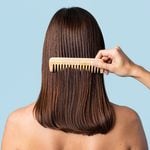6 Conditioner Myths You Need To Stop Believing RN If You Want Healthy Hair
As it turns out, there are many misconceptions about conditioner. Here, an expert sheds light on some of these common beliefs.

Myth 1: You only need to apply conditioner to the ends of your hair
This advice has come from the way conditioners used to be formulated, says Dr. Jeni Thomas, Principal Scientist for Pantene. “The belief was that you use a conditioner as a repair job and to focus on the parts where you need it,” says Thomas. But now technology has advanced – and it’s so much better for prevention.
How you should apply conditioner
Thomas recommends starting at the ends of your hair, working your conditioner in a downwards motion and then moving upwards toward your scalp. It’s important to make sure you leave a little bit of space between your scalp and how far you work the product up your hair.
There is also no set amount when it comes to how much conditioner you should be applying. It’s about experimenting with what works best for you. Thomas suggests starting off by applying your conditioner a third of the way down your hair, going halfway the next day, and then three-quarters the day after that. “Be thoughtful as to how your hair is responding,” she says.
And always think about where you’d be applying things that are stressful to your hair, like heat and ponytails. In order for your hair to receive the protective benefits that conditioner has to offer, you’ll want to make sure that you’re targeting those stress areas.
5 things you can do to reduce hair breakage this winter.
Myth 2: Conditioner repairs split ends
It’s no secret that conditioner is seen as a temporary fix with no long-lasting benefits, and that’s because conditioners can’t actually repair split ends. But Pantene’s conditioning system, which contains antioxidant and lipid replenishment actually works to help prevent chronic hair issues, meaning you’ll be less likely to form split ends in the first place.
Try to think of your hair like your skincare. You get a product and immediately see it’s working, but the longer you use the product the more benefits you reap from it. “With this kind of approach, we’re shifting into that space so that you should be able to get long-term benefits out of your conditioner, not just a quick fix,” she says.
Even though there are hair treatments that specifically target split ends, Thomas advises to stay away. “They can mend split hair, but it’s a temporary gluing effect,” she says. So when you wash your hair next, the “glue” will rinse off and you will ultimately have to cut off the split ends to get a fix.
Myth 3: Rinsing your hair with cold water will “lock in moisture”
“We’ve studied this to see if there was any truth to it and actually the shine and results were better if you rinsed in warm water,” she says. The thing is, your conditioner needs water in order to release its ingredients properly onto the hair. And within water, you have mineral content that is not so soluble if it’s cold. So, if you rinse with cold water, these minerals are not going to be able to deposit out onto your hair. Whereas with warm water, they are more likely to stay soluble.
It’s simple: To prevent your hair from looking dull, skip the cold rinse.
Save your locks this winter with the perfect hair mask for your hair type.
Myth 4: Conditioner works better the longer you leave it in
In truth, conditioner doesn’t need to sit and rest anymore. “Really with the advances that have happened in technology today, the majority of the benefits are pretty instant,” she says.
The bigger issue is: Have you taken the time to distribute it?
Myth 5: Conditioner weighs down your hair
Especially for people with fine hair, conditioner strikes the fear that if they apply too much it will weigh down their hair. But according to Thomas, “a lot of conditioner advances have been about balancing the ingredients that need to work on the inside so that you don’t have to load up the outside to get the best results.”
And exactly how much conditioner should you apply?
It’s all about how much hair you have — “how much in terms of the number of fibres, but also the length,” she says. So, if you want to fully distribute your conditioner you need to find a balance. For those already using conditioner on their ends, Thomas recommends starting with that amount and then adding a little bit more and working your way up until you’ve covered your desired amount.
Myth 6: You don’t need to use the same type of shampoo and conditioner
“We’ve looked into this a lot, both from a technical side and a consumer preference side about how important it is that you use the pair,” she says. But really, shampoo-conditioner duos are designed to work together. Thomas describes it as: The power of one (cleansing) to balance the power of the other (conditioning). (Are you using the right dry shampoo for your hair?)
Where things go wrong is if either one of your choices is a mismatch for your hair type. For instance, “if you think your hair is wavy, but you actually have fine hair and you don’t choose a product for fine hair, then you might not be very happy,” she says.
And that’s not to say that things are going to go south if you do end up using shampoo and conditioner from different brands or lines. But your overall hair results may not be as good as if you used a duo formulated to work together.




